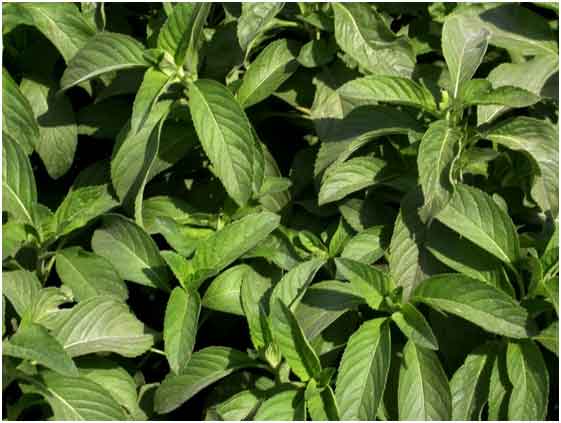
Mentha arvensis (Menthol mint) is a source of natural menthol, widely used in flavour, fragrances and aroma industry. India is a global leader in the production and export of menthol mint oil because of concrete research efforts of CSIR. The crop is popular among the small and marginal farmers of Indo-Gangetic plains where the crop covers an area of around 3 lakh hectares. The crop can be planted from the month of January to April and is harvested in the month of June before the onset of monsoon and accordingly 1-2 harvests can be obtained. An essential oil yield of 100-150 kgs from one hectare can be achieved within 3-4 months.
Improved Variety(ies) : Kosi, CIM-Kranti (CSIR-CIMAP)
Cost of cultivation : Rs. 40,000/ha
Gross return : Rs. 1,40,000/ha
Net profit : Rs. 1,00,000/ha
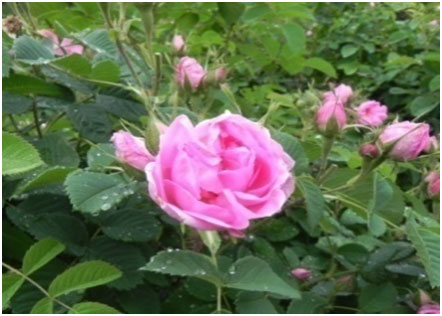
Rosa damascena (Damask Rose) is an important species among the scented roses. The plant is a perennial shrub with economic life of over 10 years. The rose can be grown from 250 to 2500 m altitude in sub-tropical to temperate climates. The rose flowers produce highly fragrant and commercially valuable essential oil and its content in the flowers is about 0.025%. About 25-30 q/ha of fresh flowers are harvested from a one-hectare area, producing 0.60 kg of rose oil. The market price of oil ranges between Rs. 5.0 to 6.0 lakh/kg. After deducting all costs, this crop gives an average net return of Rs. 2.00 lakh/ha. Other products from damask rose are rose concrete, rose absolute & rose water.
Improved Variety(ies): Himrose, Jwala, Him Basant(CSIR-IHBT), Noorjahan, Ranisahiba (CSIR-CIMAP)
Cost of cultivation: Rs. 1,00,000/ha/yr
Gross return: Rs. 3,00,000/ha/yr
Net profit: Rs. 2,00,000/ha/yr
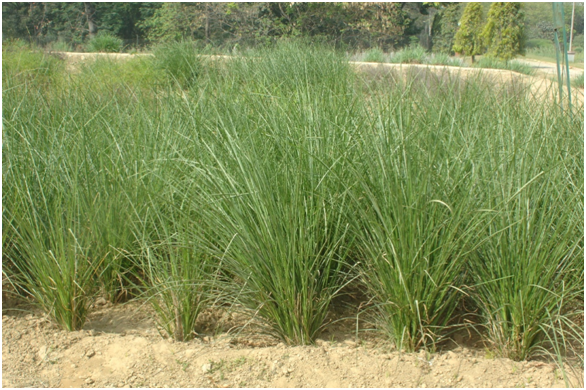
Chrysopogon zizanioides (Vetiver or Khus), a perennial, aromatic plant growing across India in variable agro climatic conditions, is being used as source of aroma in India since time immemorial. Roots of vetiver are the source of world famous “Khus oil” which has considerable value in essential oil industry. The total world production of khus oil is estimated to be 250-300 tonnes per year. In India, about 20-25 tonnes of oil is produced annually, which is much below the indigenous demand levels of the oil for perfume, essence, attar and soap industries. Khus can tolerate > 9.5 pH and annual precipitation of 6.4-41.0 cm; and therefore can be grown over wide agro-climatic conditions viz. drought prone to sub-mergence, and is also highly tolerant to soil sodicity as compared to other agricultural crops. The crop yields around 15-25 kgs of essential oil from one hectare (depending on soil conditions) with a net annual income of around Rs.1- 1.5 lakhs/ha.
Improved Variety(ies) : KS1, CIM-Vriddhi (CSIR-CIMAP)
Cost of cultivation : Rs. 1,00,000/ha
Gross return : Rs. 2,50,000-3,00,000/ha
Net profit : Rs. 1,00,000-1,50,000/ha

Lavandula officinalis (Lavender) is an aromatic crop cultivated extensively in temperate climates for extraction of essential oils. Lavender is a much sought after aromatic plant having significant position in the perfumery trade all over the world. It has multifarious uses. Beside its use in fragrance applications, predominantly body care products, Lavender oil and Lavender water has substantial applications in alternative health care practices of aromatherapy. It has a remarkable effect on the emotional and mental balance of human being. Lavender in India is mainly cultivated in Kashmir from the last week of June. Harvesting of flowers is done by a sharp sickle on bright sunny days when 50-60% florets are open. About 60-70 quintals/ha of flowers are obtained from 3rd year onwards. Flowers are immediately distilled in a unit operated by a boiler. Distillation is complete within one and a half hour. Recovery of the oil on steam distillation is 1.0-1.4%. The herb yield declines after 12-15 years of planting and plantation needs to be replanted.
Improved Variety(ies) : RRL-12 (CSIR-IIIM)
Cost of cultivation : Rs. 1,20,000/ha/yr
Gross return : Rs. 4,20,000/ha/yr
Net profit : Rs. 3,00,000/ha/yr

Pelargonium graveolens (Geranium) is an aromatic and herbaceous bushy annual plant commercially grown for its essential oil. The oil extracted from the leaves, stems and flowers of the geranium plant has strong rose-like odour and is extensively used in aroma therapy industry. Geranium can be grown in various climatic conditions in tropical cold and dry climate at a temperature of 25-30°C and humidity of 60%. Rainfall ranging from 750 mm up to 2750 mm is ideal for its cultivation. It can be successfully cultivated at altitudes from 530 m to 2400 m. The first cutting is done within 120 -150 days of planting with a second cutting after 60 – 90 days after the first cutting. An oil yield of 25 – 30 kg/ha is obtained.
Improved Variety(ies) : CIM-Pawan, Bio171 (CSIR-CIMAP), PG-IIIM-101 (CSIR-IIIM)
Cost of cultivation : Rs. 80,000/ha/yr
Gross return : Rs. 2,50,000-3,00,000/ha
Net profit : Rs. 1,70,000-2,00,000/ha
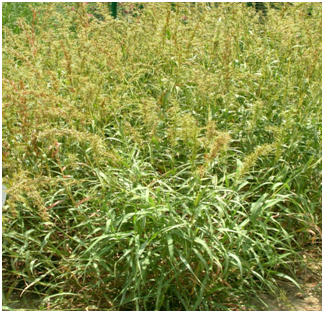
Cymbopogon martinii (Palmarosa) is widely cultivated for its aromatic oil. The essential oil of this plant, which contains the chemical compound geraniol, is valued for its scent and for a number of traditional medicinal and household uses. Palmarosa oil, which has a scent similar to roses, is also added to soaps and cosmetics. Palmarosa is generally grown in a nursery in a soil of pH of 7-8. Two or three days before planting, it is desirable to irrigate the soil to increase soil moisture above 60% before planting the seeds. Palmarosa grows well in sandy texture soil with low nitrogen, sufficient phosphorus and potassium. This crop grows slowly, taking three months to flower; once it has flowered, it can be harvested. It can be harvested three to four times a year. Under irrigated conditions, oil yield of 120-150 kg/ha/year and in un-irrigated conditions 80 kg/ha/year can be obtained.
Improved Variety(ies) : PRC1, CIM-Harsh (CSIR-CIMAP)
Cost of cultivation : Rs. 40,000/ha/yr (Irrigated), Rs. 30,000/ha/yr (Un-irrigated)
Gross return : Rs. 1,60,000/ha/yr (Irrigated), Rs. 1,00,000/ha/yr (Un-irrigated)
Net profit : Rs. 1,20,000/ha/yr (Irrigated), Rs. 70,000/ha/yr (Un-irrigated)
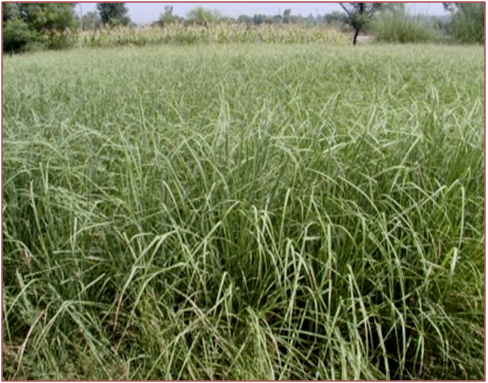
Cymbopogon nardus (Rosagrass), is a perennial, densely tufted grass, which shows profuse tillering. It is suitable for drought prone dry lands. It attains a height of 100 to 120 cm at blooming. Leaves are erect, green linear, 100 to 130 cm long and 0.8 to 1.0 cm wide. It flowers profusely twice in a year viz., March-April and September-October. No seed setting has been observed.
Improved Variety(ies) : RRL(J)CN-5, Himrosa, Tawirosa (CSIR-IIIM)
Cost of cultivation : Rs. 80,000/ha
Gross return : Rs. 2,00,000/ha
Net profit : Rs. 1,20,000/ha
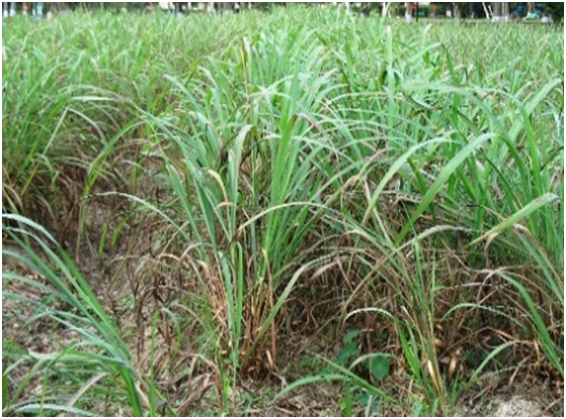
Cymbopogon winterianus (Java Citronella) finds extensive use in perfumery and is an important source of high grade aroma. Oil of Java citronella is a raw material for manufacturing aromatic chemicals such as citronellal, hydroxy citronellal, ester of geraniol and is therefore considered more important. This oil is mainly used in manufacturing of soaps, cosmetics and mosquito repellent creams. The oil is found to be effective against certain macro organisms. The deoiled grass is used in mulching, as fuel in distilling the oil and manufacture of rough paper boards. This multicut crop provides around 3 to 4 cuttings with an essential oil yield of about 200 kgs from one hectare.
Improved Variety(ies) : Bio13, CIM-Jeeva (CSIR-CIMAP), Jor Lab-C5 (CSIR-NEIST)
Cost of cultivation : Rs. 40,000/ha/year
Gross return : Rs. 1,60,000-2,00,000/ha/year
Net profit : Rs. 1,20,000-1,60,000/ha
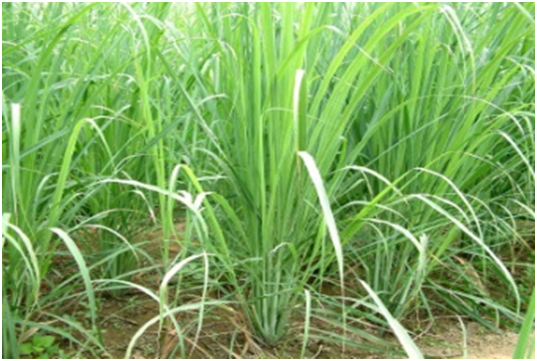
Cymbopogon flexuosus (Lemongrass)is one of the traditional essential oils of India and is a rich source of citral. The value of Lemongrass oil depends entirely upon its citral content. India produces about 700 tonnes of it and the bulk of this oil is exported. There is a considerable scope to increase the production of oil due to its rising demand and its suitability to grow in cultivable wastelands especially drought-prone areas. The lemongrass oil is used mainly in the perfumery industries and as a source of citral, from which a number of other perfumery materials are made. The oil is widely used in cosmetics and germicidal preparations. The dried spent grass is also used as fuel for the distillation of the oil. It can also be used for the manufacture of paper and cardboards. The crop provides 3-4 cuts in a year yielding about 100-150 kgs of essential oil from one hectare depending on soil conditions.
Improved Variety(ies) : Krishna, CIM-Shikhar (CSIR-CIMAP), Jor Lab-L8 (CSIR-NEIST), CKP-25, Kalam (CSIR-IIIM)
Cost of cultivation : Rs. 40,000/ha/year (Irrigated), Rs. 30,000/ha/year (Un-irrigated)
Gross return : Rs. 1,60,000/ha/year (Irrigated), Rs. 1,00,000/ha/year (Un-irrigated)
Net profit : Rs. 1,20,000/ha/year (Irrigated), Rs. 70,000/ha/year (Un-irrigated)
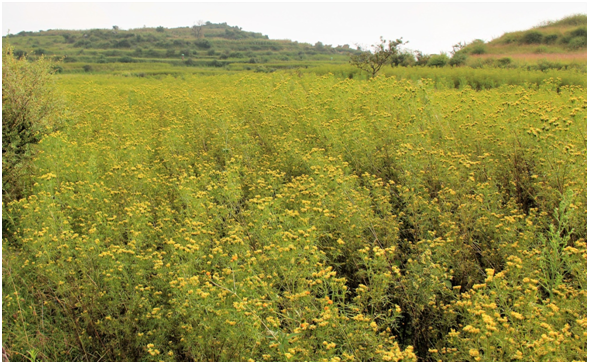
Tagetes minuta (Wild marigold) is a hardy plant and suitable for mid Himalayan region. Crop gives higher oil yield of better quality oil among all cultivated species. CSIR-IHBT has standardized agro- and processing technologies and released an improved variety “Himgold”. By adopting standardized agrotechnology, crop biomass upto 200 q/ha can be harvested. The oil content ranges between 0.25 to 0.40%. The major constituents of the Tagetes oil are Ocimene (Z and E), Limonene, Dihydro tagetone, Tagetone (Z and E). The oil is used in blending high grade perfumes. The crop gives a net return of Rs 1.5-2 lakhs per hectare.
Improved Variety(ies) : Himgold (CSIR-IHBT)
Cost of cultivation : Rs. 50,000/ha
Gross return : Rs. 2,00,000/ha
Net profit : Rs. 1,50,000/ha

Pogstemon cablin (Patchouli), also known as 'scent of the sixties' has a musky, earthy and exotic aroma. The essential oil of patchouli is obtained from the shade dried leaves of this plant and used for providing stability of the aroma of other essential oils used in the perfumery industry. The crop requires high humidity and moderate temperature ranging from 22-28°C. Climate of north-eastern states is ideal for its commercial cultivation where 3-4 cuttings can be easily obtained in an year. This multi-cut crop yields about 50-100 kgs of essential oil from one hectare (depending on the environment). The crop can be successfully integrated into orchards and plantations.
Improved Variety(ies) : CIM-Shreshta (CSIR-CIMAP)
Cost of cultivation : Rs. 50,000/ha/year
Gross return : Rs. 2,00,000-3,00,000/ha/year
Net profit : Rs. 1,50,000-2,50,000/ha/year
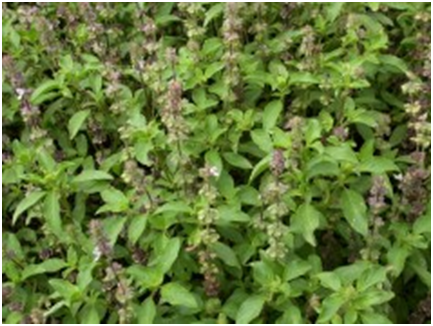
Ocimum (Tulsi), popularly known as Basil, is native to Indian subcontinent and is cultivated throughout Southeast Asian tropics. The plant contains mainly phenols, aldehydes, tannins, saponin and fats. The essential oil major components vary with the species being cultivated and generally essential oil of ocimum are rich in methyl chavicol, linalool, eugenol etc. Ocimum is an important aromatic and medicinal plant which yields various kinds of essential oils and aroma chemicals and find diverse uses in perfumery, cosmetic industries, aromatherapy and also in indigenous systems of medicine. The crop yields about 200 quintals/ha of biomass yielding about 100 kg/ha of essential oil. The crop takes about 60-70 days to mature and, therefore, can be taken as rain-fed crop during monsoon.
Improved Variety(ies) : CIM-Saumya, CIM-Jyoti (CSIR-CIMAP), RRL-OG-14 (CSIR-IIIM)
Cost of cultivation : Rs. 20,000/ha
Gross return : Rs. 60,000/ha
Net profit : Rs. 40,000/ha
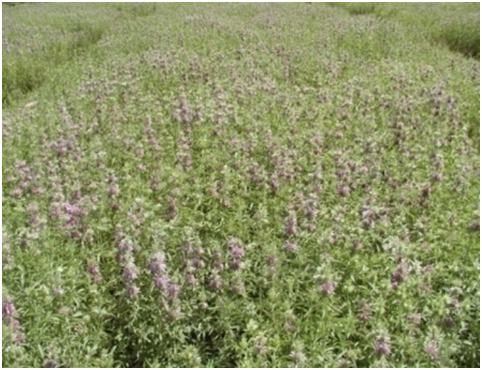
Monarda citriodora (Jammu Monarda) is one of the essential oil yielding herbaceous plant. The plant was introduced in India by Scientists of CSIR-IIIM, Jammu during 1999 from Europe. Detailed chemical examination confirmed it to be a new source of thymol which otherwise is obtained from Ajowain (Trachyspermum amme). The chemical constituents of the essential oil are Thymol (62-70%), Carvacrol (2-6%), p-cymene (12-20%), -terpinene (14-20%). The oil is likely to have medicinal activity and suitable for perfumery and flavouring of food industry etc. The essential oil and Thymol are having anti-bacterial properties.
Improved Variety(ies) : IIIM(J) MC-02 (CSIR-IIIM)
Cost of cultivation : Rs. 50,000/ha
Gross return : Rs. 2,00,000/ha
Net profit : Rs. 1,50,000/ha
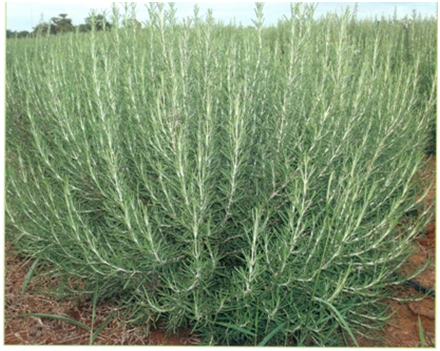
Rosmarinus officinalis (Rosemary) is a woody, perennial herb with fragrant, evergreen, needle-like leaves and white, pink, purple, or blue flowers, native to the Mediterranean region. It can withstand droughts, surviving a severe lack of water for lengthy periods. It can be cultivated in Nilgiris, Himachal Pradesh, Jammu and Kashmir and Uttarakhand hilly regions. Rosemary leaves are used as flavouring in foods and herbal tea. Rosemary oil is used for purposes of fragrant bodily perfumes or to emit an aroma into a room. It is also burnt as incense, and used in shampoos and cleaning products. The major constituents of rosemary are 1, 8-cineole (20-50%), borneol (20%). The herb (dried leaves) yield of this crop is around 100-150 quintals/ha/year which can yield, on distillation, about 100-150 kg/ha/year of essential oil.
Improved Variety(ies) : CIM-Hariyali (CSIR-CIMAP)
Cost of cultivation : Rs. 60,000/ha/year
Gross return : Rs. 2,40,0000/ha/year
Net profit : Rs. 1,80,000/ha/year
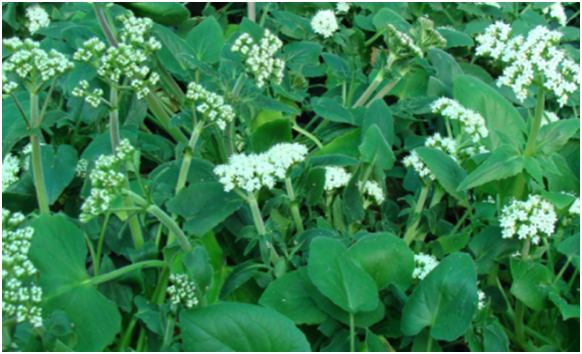
Valariana jatamansi (Muskbala) is suitable for hilly areas in 1500-3500 m altitude and is grown both for aromatic and medicinal purposes. Its roots are used in herbal drugs as tranquilliser, sedative and stimulant. The crop duration is two years. The fresh underground parts of V. jatamansi contain 0.4 % essential oil. The institute has developed an improved cultivar “Himbala”, which produces 15 kg oil/ha. The crop holds promise under agro-forestry system for additional income to the growers. The net profit after two years of cultivation is Rs 1.5 lakhs per hectare.
Improved Variety(ies) : Himbala (CSIR-IHBT)
Cost of cultivation : Rs. 50,000/ha
Gross return : Rs. 2,00,000/ha
Net profit : Rs. 1,50,000/ha

Dracocephalum heterophyllum (Thimsingli) is a native of the western Himalaya belonging to Lamiaceae family. The plant grows wild at 3000-5200 m elevation in northern part including J&K, HP, UK and Sikkim. The essential oil content ranges between 0.17- 0.45%. The presence of cis and trans rose oxides in the sweet, rosaceous essential oil renders its valuable use in perfumery and cosmetic products. The essential oil has anti-asthmatic, anti-coughing and disinfectant actions. The plant was introduced and domesticated by CSIR-IHBT and subsequently an improved variety “Him Surabh” was developed. It is a potential crop to meet increasing demand of phytochemical industries.
Improved Variety(ies) : Him Surabh (CSIR-IHBT)
Cost of cultivation : Rs. 50,000/ha
Gross return : Rs. 2,00,000/ha
Net profit : Rs. 1,50,000/ha

Artemisia maritima (Sea wormwood) is suitable for cold desert Himalayan region and grows well at an altitude of 4000 m. This plant is traditionally used as an insect repellent. The potential use of its essential oil, so far, has remained unexplored. The essential oil yield ranges between 0.3%-0.5%. The major constituents of the oil are 1,8 Cineole and Sesquiterpene Hydrocarbons.
Cost of cultivation : Rs. 50,000/ha
Gross return : Rs. 2,00,000/ha
Net profit : Rs. 1,50,000/ha
(Quality planting material available at CSIR-IHBT)